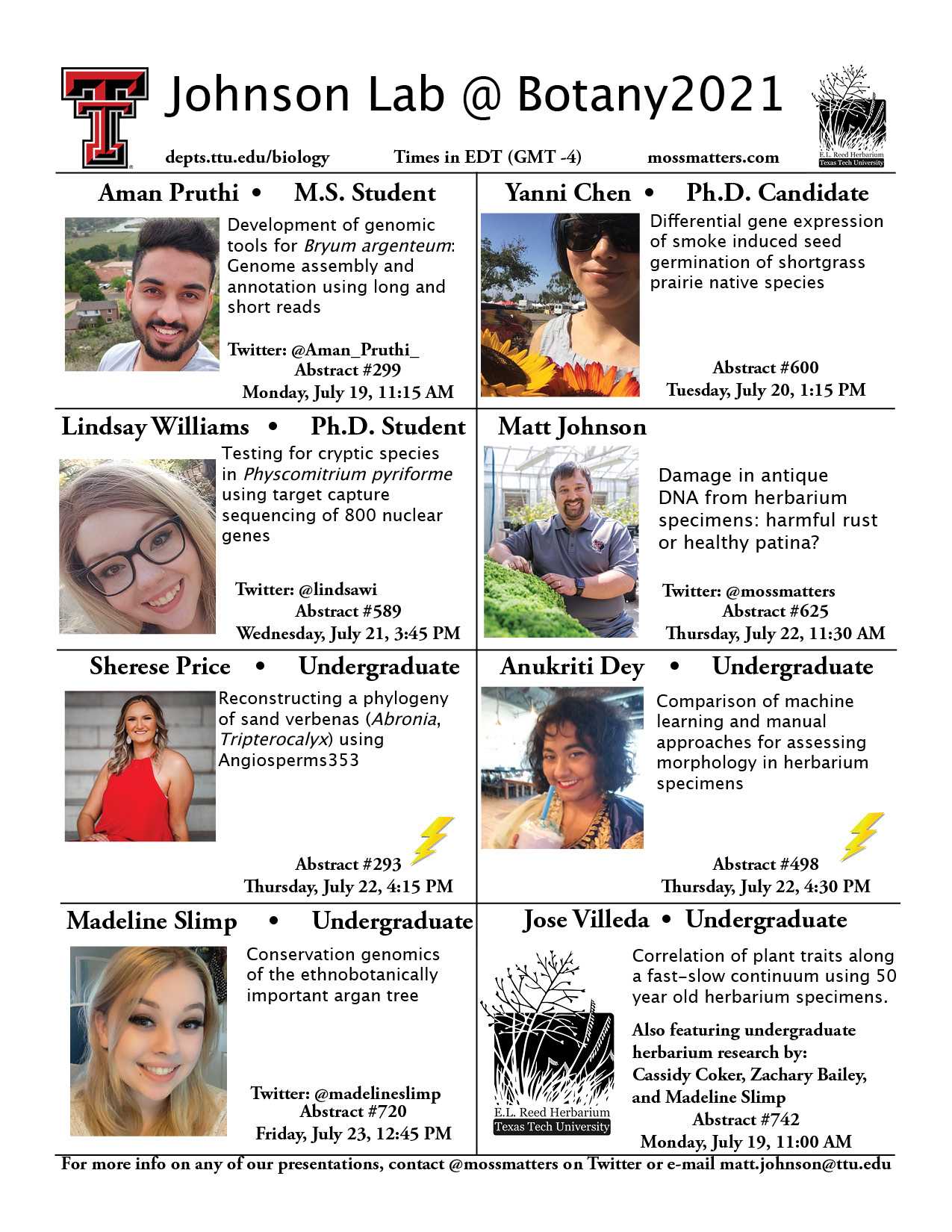Botany 2021

Johnson Lab Talks at Botany 2021.
The best week of the year for botany research has arrived - and the Johnson Lab is prepared for a great virtual Botany2021! There will be eight talks featuring research done by graduate students and undergraduates in the lab and the E.L. Reed Herbarium. Here are the Johnson Lab talks (times listed in EDT, GMT-4).
- “Development of genomic tools for Bryum argenteum: Genome assembly and annotation using long and short reads” M.S. Student Aman Pruthi is giving an update on the Bryum argenteum genome assembly he’s been working on the past couple of years. This project is funded by the United States Golf Association, because of the impact “silvery-threaded moss” has had on putting greens around North America. Aman used long reads from Nanopore PromethION and short reads from Illumina NovaSeq to create a draft assembly. Abstract #299, Monday July 19 11:15 AM.
- “Differential gene expression of smoke induced seed germination of shortgrass prairie native species” Ph.D. Candidate Yanni Chen is studying the effects of smoke on seed germination, and this talk focuses on her differential expression analysis. Using seeds from the native grass Bouteloua gracilis, Yanni used RNAseq to identify genes responding to smoke water compared to normal water prior to germination. She compares her results to those known from model organisms to see if the same genes show differential expression in this non-model species. Abstract #600
Tuesday, July 20, 1:15 PM.
- “Testing for cryptic species in Physcomitrium pyriforme using target capture sequencing of 800 nuclear genes.” Ph.D. Student Lindsay Williams is continuing a 130 year discussion about the number of species represented by “goblet moss” in eastern North America. Collecting hundreds of samples from across the range was helped in big part by iNaturalist users through the PhyscoHunt community science project. Using HybSeq, Lindsay is able to identify distinct genetic clusters with overlapping ranges – could they be separate species? Abstract #589
Wednesday, July 21, 3:45 PM.
- “Damage in antique DNA from herbarium specimens: harmful rust or healthy patina?” PI Matt Johnson investigates whether patterns of DNA damage long known to occur in ancient samples also affect herbarium specimens. An Artocarpus target capture data set was used to identify deamination - the spontaneous mutation of cytosine to uracil - and determine the effect this process would have on phylogenies that incorporate herbarium specimens. Abstract #625
Thursday, July 22, 11:30 AM
- “Reconstructing a phylogeny of sand verbenas (Abronia, Tripterocalyx) using Angiosperms353” Undergraduate Sherese Price began working with Abronia and target capture data as part of a course and continued in the lab to help produce a taxon-complete phylogenetic dataset with Angiosperms353. Lightning Talk Abstract #293
Thursday, July 22, 4:15 PM.
- “Comparison of machine learning and manual approaches for assessing morphology in herbarium specimens” Undergraduate Anukriti Dey manually measured leaves of Aslepias asperula in hundreds of herbarium specimens using imageJ and compared this to the speed and accuracy of automated methods like LeafMachine. Find out the pros and cons at her Lightning Talk Abstract #498 Thursday, July 22, 4:30 PM.
- “Conservation genomics of the ethnobotanically important argan tree” Undergraduate Madeline Slimp is using Angiosperms353 as a tool for conservation genetics, looking at the endandgered and ethonbotanically important Sideroxylon spinosum across its range in Morocco. Using sampling similar to earlier efforts with ISSR and microsatellite markers, Madeline identifies population structure within the region, which will help inform conservation efforts. Abstract #720 Friday, July 23, 12:45 PM.
The Johnson Lab will also be represented in a by Jose Villeda, an undergraduate in the Smith Lab at Texas Tech. Jose’s talk, Correlation of plant traits along a fast-slow continuum using 50 year old herbarium specimens features elemental analysis, stomatal density, and georeferencing work conducted by Johnson Lab undergraduates Cassidy Coker, Zach Bailey, and Madeline Slimp. Abstract #742 Monday, July 19, 11:00 AM
Follow along with our Botany2021 experience on Twitter!